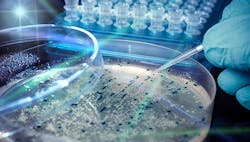A one-pot process using genetically engineered bacteria converts terephthalic acid into vanillin, report its developers at the University of Edinburgh, Scotland. The scientists say this is the first example of using a biological system to upcycle plastic waste into a valuable industrial chemical.
Besides its role as a flavoring, vanillin finds use in cosmetics, herbicides, anti-foaming agents and cleaning products. Global demand reportedly approaches 40,000 t/y; Grand View Research, San Francisco, predicts the market will reach $724.5 million by 2025.
The one-pot reaction is carried out in E. coli bacteria and occurs at room temperature and pH 5.5–7 in aqueous media. It requires no additional cofactors or reagents, and generates no hazardous waste. Current conversions exceed 79%. More details appear in an article in a recent issue of Green Chemistry.
Temperature, cell permeabilization and in-situ product removal are key factors in optimizing the process, notes principal investigator Stephen Wallace. “We’re currently investigating the reasons why these factors were so successful with the aim of trying to improve them further. We’re also looking into biological methods to increase flux through the pathway by engineering the cell membrane,” he says.
Wallace and his team in Edinburgh’s Department of Biological Sciences also are looking to intensify the process further using strain engineering and by extending the pathway to other metabolites.
“Many of the intermediates en route to vanillin from terephthalic acid are central metabolites that are commonly used in many biosynthetic pathways to other useful industrial molecules. The target compounds we are now focusing on are used in the food/flavoring and pharmaceutical industries. This is really just the beginning for us,” he adds.
Chemical engineering issues such as downstream processing will pose their own challenges when the team gets to that point, Wallace believes.
Even so, the work already has attracted a great deal of interest from industry. “We are currently seeking further investment with them in the form of grants to conduct follow-on, scale-up studies later this year,” he reveals.
One outstanding issue is whether the vanillin produced in this way is fit for human consumption. “The regulatory requirements for human consumption are very complex. However, when you consider that 85% of vanillin that is manufactured today is derived from crude oil — specifically phenol — I’m optimistic that a bio-based approach from PET could meet these same requirements in the future,” Wallace concludes.
About the Author
Seán Ottewell
Editor-at-Large
Seán Crevan Ottewell is Chemical Processing's Editor-at-Large. Seán earned his bachelor's of science degree in biochemistry at the University of Warwick and his master's in radiation biochemistry at the University of London. He served as Science Officer with the UK Department of Environment’s Chernobyl Monitoring Unit’s Food Science Radiation Unit, London. His editorial background includes assistant editor, news editor and then editor of The Chemical Engineer, the Institution of Chemical Engineers’ twice monthly technical journal. Prior to joining Chemical Processing in 2012 he was editor of European Chemical Engineer, European Process Engineer, International Power Engineer, and European Laboratory Scientist, with Setform Limited, London.
He is based in East Mayo, Republic of Ireland, where he and his wife Suzi (a maths, biology and chemistry teacher) host guests from all over the world at their holiday cottage in East Mayo.

